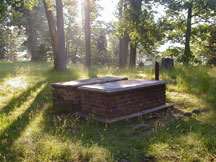
|
Robert Monteath died in 1778, two years prior to Robert Erskine
(1780). Erskine probably chose the location and stone for Monteath
and Elizabeth Erskine probably chose the location for Erskine's tomb
next to Monteath. This tomb restoration was begun in 2001 and completed
in 2002. |
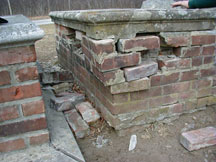
|
The tomb of Monteath had been deteriorating gradually for many years.
The North Jersey Highlands Historical Society had fixed Robert Erskine's
tomb in the 1980s and now decided to fix Monteath's. |
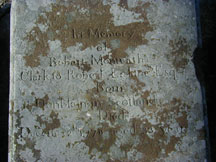 |
Monteath's tombstone was made during the Revolutionary war. Although
the script has deteriorated, the viewer can get a sense of how different
stonecarving was in those days - almost like handwriting. You can
imagine the stonecarver, during the War, hurridly spelling out the
words with a chisel on the stone. |
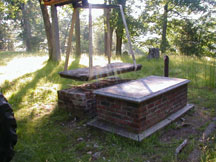 |
The first step was to carefully remove the historic tombstone and
transport it to storage. Our plan was to recreate the original style
of stonecarving (handwriting) on a new, granite tombstone that would
last through at least a century of acid rain. |
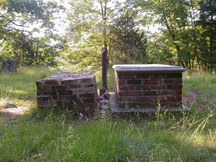
|
Originally the stones were lying on the ground. In the 19th century,
the Hewitt family had brick bases built and replaced Erskine's tombstone
with a more modern version (for those times). Erskine's tombstone
was restored again in 1985 by the North Jersey Highlands Historical
Society. It now has a granite slab stone with standard font face letters,
similar to the restoration completed by the Hewitts. |
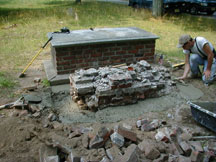 |
The next step was to replace the brick base and cement grounding.
The base had to be solid to withstand freezing and thawing and support
the slab stone. Here the masons are using a mixture of used bricks,
original bricks and cement to create a solid base. The bricks all
had their own markings, and I know they came from brick companies
in the area, but I don't know enough about them to date or identify
them. |
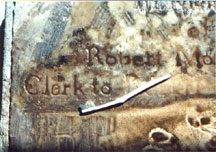 |
In an attempt to preserve the style of 18th century tombstone engraving,
we copied the old-style lettering, mistakes and all. Since the stone
is over 200 years old, we scrubbed the surface to see the lettering
that was covered by lichens. At first, we were only looking for the
dots to the "i"s, but instead we found whole words that were buried
by the centuries. |
 |
When the restoration was complete, I took this picture. The attempt
to re-capture the 18th century gravestone engraving had mixed results.
Our processes are too different. Nevertheless the tomb is repaired. |


